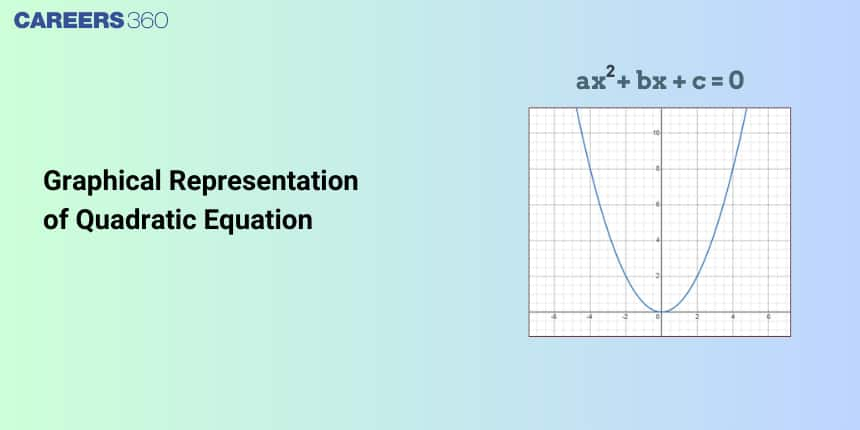Graphical Representation of Quadratic Equation
A quadratic graph depicts a U-shaped curve drawn for a quadratic function. In Mathematics, a parabola is one of the conic sections, which is formed by the intersection of a right circular cone by a plane surface. It is a symmetrical plane U-shaped curve. A parabola graph whose equation is in the form of
JEE Main: Study Materials | High Scoring Topics | Preparation Guide
JEE Main: Syllabus | Sample Papers | Mock Tests | PYQs
- What is a Parabola Graph?
- Standard Form of Parabola Equation
- Vertex Form of Parabola Equation
- Solved Examples Based on Graph of Quadratic Equations

In this article, we will cover the concept of the graph of quadratic equations. This concept falls under the broader category of complex numbers and quadratic equations, a crucial Chapter in class 11 Mathematics. It is not only essential for board exams but also for competitive exams like the Joint Entrance Examination (JEE Main), and other entrance exams such as SRMJEE, BITSAT, WBJEE, BCECE, and more.
What is a Parabola Graph?
A parabola is a U-shaped curve that is drawn for a quadratic function,
Vertex
The vertex of parabola will represent the maximum and minimum point of parabola.
Axis of Symmetry
The axis of symmetry of parabola always passes through its vertex and is parallel to y-axis.
y-intercept
The point at which the parabola graph passes through the y-axis is called y-intercept. The parabola of quadratic function passes through an only a single point at the y-axis,
x-intercepts
The points at which the parabola graph passes through the x-axis, are called x-intercepts, which expresses the roots of quadratic function.
Standard Form of Parabola Equation
The equation of parabola can be expressed in two different ways, such as the standard form and the vertex form. The standard form of parabola equation is expressed as follows:
The orientation of the parabola graph is determined using the "a" value.
If the value of
If the value of
The axis of symmetry from the standard form of the parabola equation is given as:
Vertex Form of Parabola Equation
The extreme point of a parabola, whether it is maximum or minimum, is called the vertex of the parabola. The parabola equation can also be represented using the vertex form.
Vertex Form of a Parabola:
Here,
Similar to the standard form of the parabola equation, the orientation of the parabola in the vertex form is determined by the parameter "
- If the value of
- If the value of
How to graph a quadratic function ?
We have
Expression
which on further simplification is converted in the form of
Now, let
The shape of the
Vertex of the parabola will be
If the parabola opens upward (when a > 0) then the y value of the vertex represents the least value of the equation, and if opens downward (when a < 0) then the y value of the vertex represents the greatest value of the parabola.
Both least and greatest values are attained at the x value of the vertex of the parabola
Hence the graph of any general quadratic equation will look like the below graph (given a>0)

In the general quadratic equation if
Then the parabola opens upward. As given below,

if a < 0 it opens downward. As given below,

Important points on Graphing Quadratic Functions
- The graph of the quadratic function is in the form of a parabola.
- The coefficient a in
- Graphing Quadratic Functions can be done using both general form and vertex form.
Recommended Video Based on Graph of Quadratic Equations
Solved Examples Based on Graph of Quadratic Equations
Example 1:
1)
2)
3)
4)
Solution:
As we learned in
Quadratic Expression Graph when
No Real and Equal root of
Example 2: If equations
1)
2)
3)
4)
Solution:
As we have learned
Quadratic Expression Graph when a
No Real and Equal root of
- wherein
Condition for both roots common -
are the 2 equations
So, non-real roots which means both roots are common (as complex roots occur in conjugate )
So, a:b:c
Example 3: The value of
Solution:
Sum of Roots in Quadratic Equation -
Product of Roots in Quadratic Equation -
- wherein
Quadratic Expression Graph when
No Real and Equal root of
Given quadratic equation
roots are
from the concept
least value when
Hence, the answer is 2 .
Example 4: Let
1)
2)
3)
4)
Solution:
Solution:
As we learned in
Quadratic Expression Graph when
Real and Equal roots of
\&
- wherein
Example 5: Let
Solution:
As we learned in
Quadratic Expression Graph when
Real and Equal roots of
- wherein
For
Frequently Asked Questions (FAQs)
A polynomial that has degree two is called a quadratic equation.
The discriminant of the quadratic equation is given by
Standard and vertex forms are two ways to express parabola equations.
The standard form of the parabola equation is
Also Read
04 Aug'25 07:39 PM
23 Jul'25 04:20 PM
02 Jul'25 08:09 PM
02 Jul'25 08:07 PM
02 Jul'25 08:06 PM
02 Jul'25 08:06 PM
02 Jul'25 08:03 PM
02 Jul'25 08:02 PM
02 Jul'25 08:02 PM
02 Jul'25 08:01 PM


